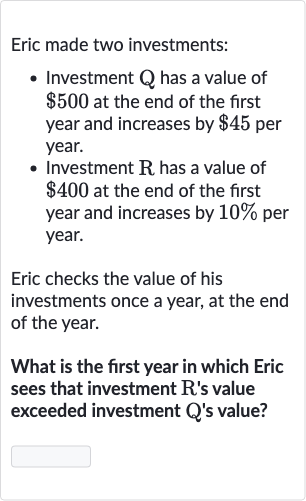AI tutor
Welcome to Bytelearn!
Let’s check out your problem:

Eric made two investments:- Investment has a value of at the end of the first year and increases by per year.- Investment has a value of at the end of the first year and increases by per year.Eric checks the value of his investments once a year, at the end of the year.What is the first year in which Eric sees that investment 's value exceeded investment Q's value?
Full solution
Q. Eric made two investments:- Investment has a value of at the end of the first year and increases by per year.- Investment has a value of at the end of the first year and increases by per year.Eric checks the value of his investments once a year, at the end of the year.What is the first year in which Eric sees that investment 's value exceeded investment Q's value?
- Define : Step : Define the value of investment after years.Investment starts at and increases by each year. So, the value of investment after years can be represented as:
- Define : Step : Define the value of investment after years.Investment starts at and increases by each year. The value of investment after years can be represented as:
- Determine year when exceeds : Step : Determine the year when exceeds .We need to find the smallest integer for which R(n) > Q(n) . This means we are looking for the smallest such that: 400 \times (1.10)^n > 500 + 45n
- Solve inequality: Step : Solve the inequality by trial and error or algebraically.Since the inequality involves an exponential term and a linear term, it's not straightforward to solve algebraically. We will use trial and error, starting with and increasing until exceeds .
- Calculate and for : Step : Calculate the value of and for successive years.For : is not greater than .
- Increment and calculate: Step : Increment and calculate again.For : is not greater than .
- Continue incrementing : Step : Continue incrementing .For : is not greater than .
- Continue incrementing : Step : Continue incrementing .For : is not greater than .
- Continue incrementing : Step : Continue incrementing .For : is not greater than .
- Continue incrementing : Step : Continue incrementing .For : is not greater than .
- Continue incrementing : Step : Continue incrementing .For : is not greater than .
- Continue incrementing : Step : Continue incrementing .For : is not greater than .
- Continue incrementing : Step : Continue incrementing .For : is greater than . Therefore, the first year in which investment R's value exceeded investment Q's value is after years.
More problems from Interpret the exponential function word problem
QuestionGet tutor help
QuestionGet tutor help
QuestionGet tutor help
QuestionGet tutor help
QuestionGet tutor help
QuestionGet tutor help
QuestionGet tutor help
QuestionGet tutor help
QuestionGet tutor help
